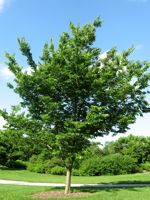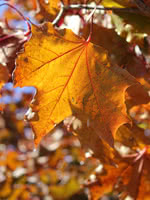Mon-Fri 9am - 5pm Mountain time
Common Hackberry vs Norway Maple
Celtis occidentalis
Acer platanoides
CUSTOM GROW
The Common Hackberry is a medium-sized deciduous tree that resembles the American Elm but is immune to Dutch Elm Disease. They are versatile and can adapt to a variety of growing conditions.
It produces purple-red, berry-like fruit with a large seed in the center. Both the sweet flesh, which tastes similar to dates, and the crunchy seed are edible. The fruit remains on the tree throughout the winter, offering a valuable food source for birds and other wildlife.
The Common Hackberry can also be a great addition to a pollinator garden. The tree itself is a host for the larvae of several butterfly species and the flowers provide a source of pollen and nectar.
Norway Maple is a tolerant and adaptable shade tree. This is probably why it is the most popularly planted boulevard tree in North America.
Note: Norway Maple will sucker with age. It's also not a good idea to plant it under power lines.

